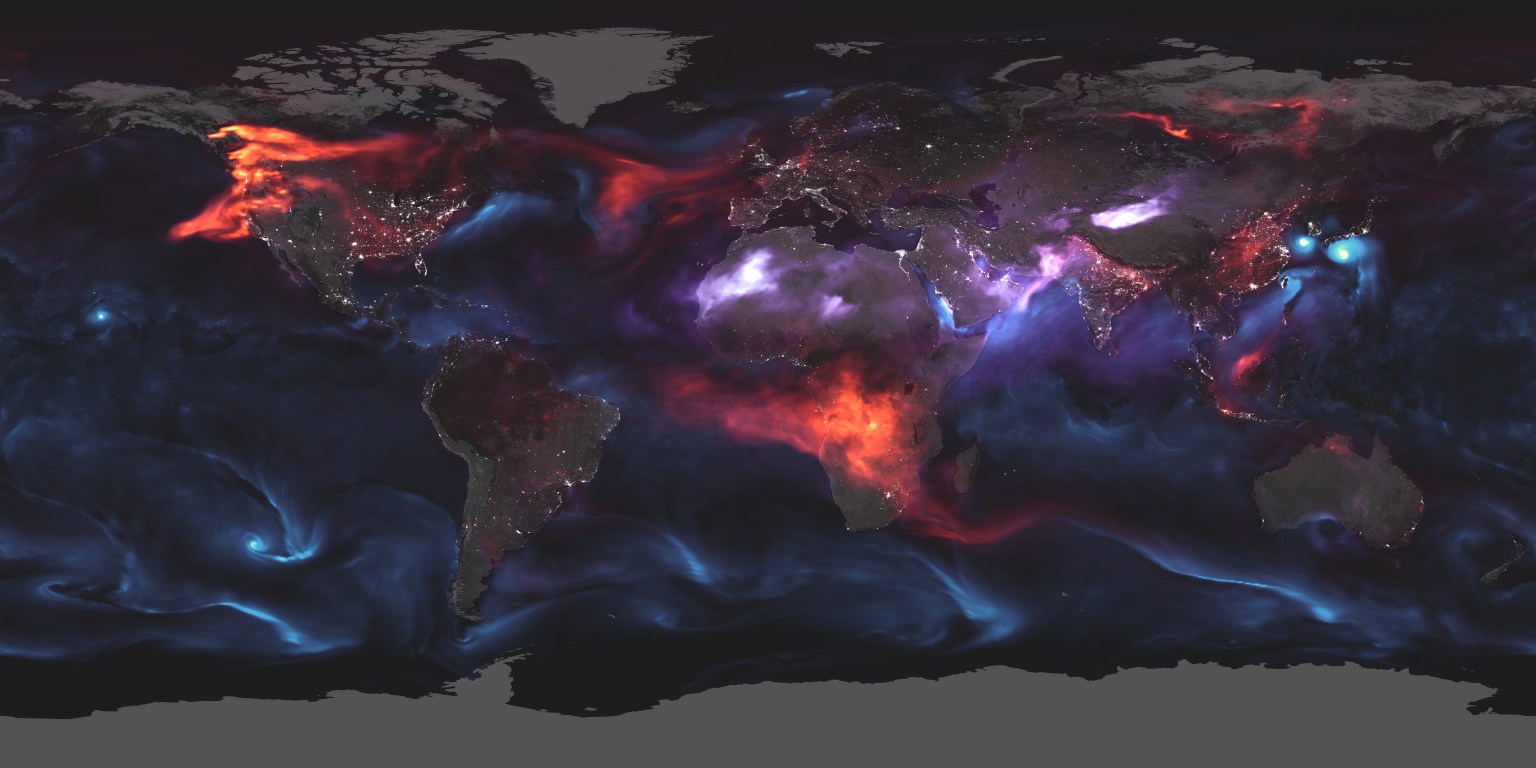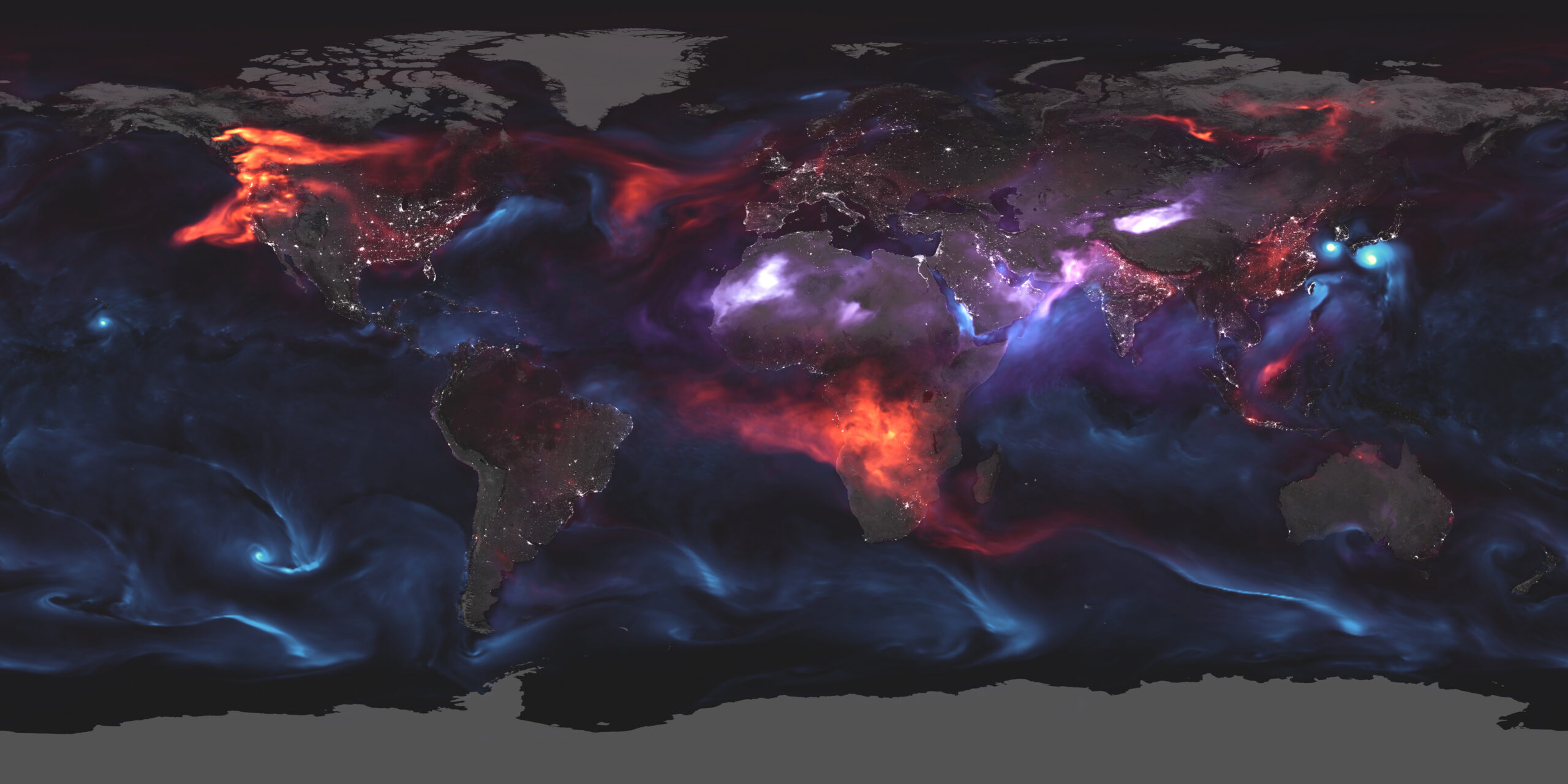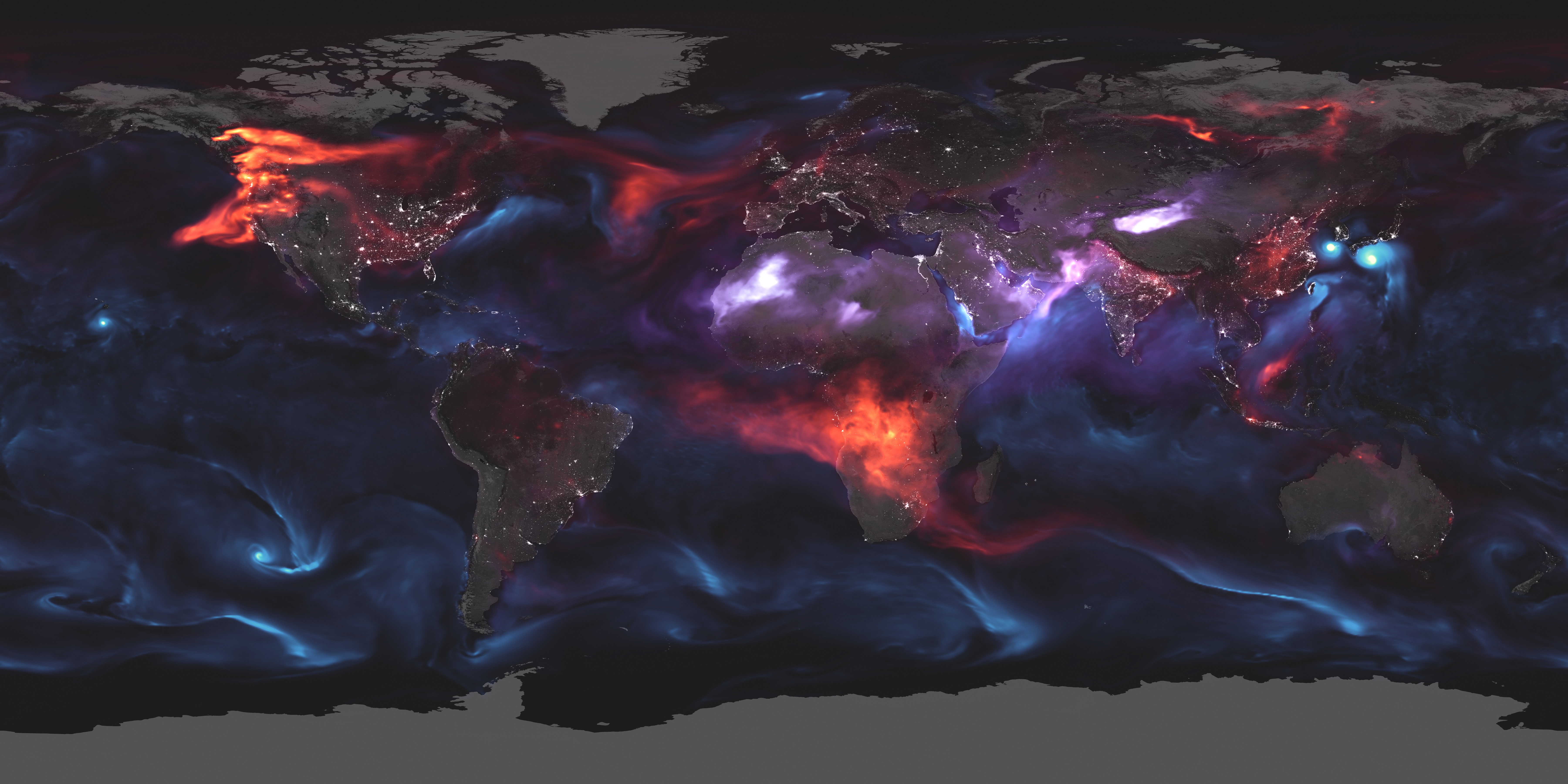4 Min Read NASA Data Helps Protect US Embassy Staff from Polluted Air  This visualization of aerosols shows dust (purple), smoke (red), and sea salt particles (blue) swirling across Earth’s atmosphere on Aug. 23, 2018, from NASA’s GEOS-FP (Goddard Earth Observing System forward processing) computer model. Credits:
This visualization of aerosols shows dust (purple), smoke (red), and sea salt particles (blue) swirling across Earth’s atmosphere on Aug. 23, 2018, from NASA’s GEOS-FP (Goddard Earth Observing System forward processing) computer model. Credits:
NASA’s Earth Observatory United States embassies and consulates, along with American citizens traveling and living abroad, now have a powerful tool to protect against polluted air, thanks to a collaboration between NASA and the U.S. State Department.
Since 2020, ZephAir has provided real-time air quality data for about 75 U.S. diplomatic posts. Now, the public tool includes three-day air quality forecasts for PM2.5, a type of fine particulate matter, for all the approximately 270 U.S. embassies and consulates worldwide. These tiny particles, much smaller than a grain of sand, can penetrate deep into the lungs and enter the bloodstream, causing respiratory and cardiovascular problems.
“This collaboration with NASA showcases how space-based technology can directly impact lives on the ground,” said Stephanie Christel, climate adaptation and air quality monitoring program lead with the State Department’s Greening Diplomacy Initiative. “This is not something the State Department could have done on its own.” For instance, placing air quality monitors at all U.S. diplomatic posts is prohibitively expensive, she explained.
“NASA’s involvement brings not only advanced technology,” she added, “but also a trusted name that adds credibility and reliability to the forecasts, which is invaluable for our staff stationed abroad.”
The forecasts, created using NASA satellite data, computer models, and machine learning, are crucial for U.S. embassies and consulates, where approximately 60,000 U.S. citizens and local staff work. Many of these sites are in regions with few local air quality monitors or early warning systems for air pollution.
“ZephAir’s new forecasting capability is a prime example of NASA’s commitment to using our data for societal benefit,” said Laura Judd, an associate program manager for Health and Air Quality at NASA. “Partnering with the State Department allows us to extend the reach of our air quality data, providing embassies and local communities worldwide with vital information to protect public health.”
Enhancing Health, Safety with NASA Air Quality Data To manage air pollution exposure, the tool can assist diplomatic staff with decisions on everything from building ventilation to outdoor activities at embassy schools.
For many embassies, especially in regions with severe air pollution, having reliable air quality forecasts is crucial for safeguarding staff and their families, influencing both daily decisions and long-term planning. “Air quality is a top priority for my family as we think about [our next assignment], so having more information is a huge help,” said Alex Lewis, a political officer at the U.S. embassy in Managua, Nicaragua.
 A screenshot of the ZephAir web dashboard featuring air quality forecasts for Managua, Nicaragua. U.S. Department of State Previously, ZephAir only delivered data on current PM2.5 levels using air quality monitors on the ground from about 75 U.S. diplomatic locations and about 50 additional sources. Now, the enhanced tool provides PM2.5 forecasts for all sites, using the Goddard Earth Observing System forward processing (GEOS-FP), a weather and climate computer model. It incorporates data on tiny particles or droplets suspended in Earth’s atmosphere called aerosols from MODIS (Moderate-resolution Imaging Spectroradiometer) on NASA’s Terra and Aqua satellites.
A screenshot of the ZephAir web dashboard featuring air quality forecasts for Managua, Nicaragua. U.S. Department of State Previously, ZephAir only delivered data on current PM2.5 levels using air quality monitors on the ground from about 75 U.S. diplomatic locations and about 50 additional sources. Now, the enhanced tool provides PM2.5 forecasts for all sites, using the Goddard Earth Observing System forward processing (GEOS-FP), a weather and climate computer model. It incorporates data on tiny particles or droplets suspended in Earth’s atmosphere called aerosols from MODIS (Moderate-resolution Imaging Spectroradiometer) on NASA’s Terra and Aqua satellites.
Aerosols are tiny airborne particles that come from both natural sources, like dust, volcanic ash, and sea spray, and from human activities, such as burning fossil fuels. PM2.5 refers to particles or droplets that are 2.5 micrometers or smaller in diameter — about 30 times smaller than the width of a human hair.
“We use the GEOS-FP model to generate global aerosol forecasts,” said Pawan Gupta, of NASA’s Goddard Space Flight Center in Greenbelt, Maryland, and the lead scientist on the project. “Then we calibrate the forecasts for embassy locations, using historical data and machine learning techniques.”
As of August 2024, the forecasting feature is available on the ZephAir web and mobile platforms.
The new forecasts are about more than just protecting U.S. citizens and local embassy staff; they are also contributing to global action on air quality. The State Department engages with local governments and communities to raise awareness about air quality issues. “These forecasts are a critical part of our strategy to mitigate the impacts of air pollution not only for our personnel but also for the broader community in many regions around the world,” Christel said.
Officials with the Greening Diplomacy Initiative partnered with NASA through the Health and Air Quality Applied Sciences Team to develop the new forecasts and will continue the collaboration through support from the Satellite Needs Working Group.
Looking ahead, the team aims to expand ZephAir’s capabilities to include ground-level ozone data, another major pollutant that can affect the health of embassy staff and local communities.
By Emily DeMarco
NASA’s Earth Science Division, Headquarters
Details Last Updated Sep 20, 2024 Editor Rob Garner Contact Rob Garner rob.garner@nasa.gov Location Goddard Space Flight Center Related Terms Aqua Benefits Back on Earth Earth Earth’s Atmosphere Goddard Space Flight Center Terra


